Chaucer and his times
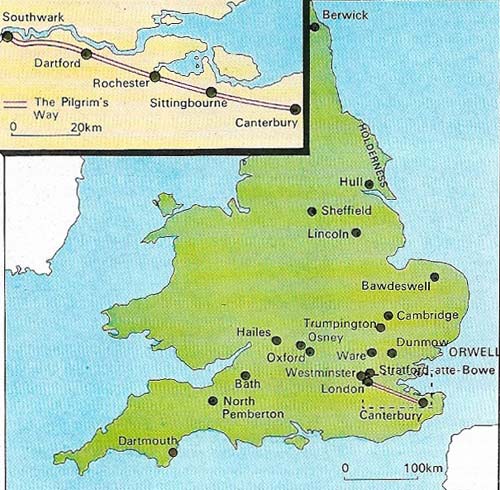
Figure 1. The England of the Canterbury Tales. was mainly confined to the southeastern part of the country, and was dominated by London and, of course, Canterbury, to which the pilgrims were journeying to visit the tomb of St Thomas Becket. (c. 1118–1170). Even though the population of every other town in the country had fallen since 1330 because of the ravages of the Black Death, London's continued to rise because of constant immigration, and it stood at more than 50,000 in 1400. Southeast England was the richest and most populous area at that time and the dialect of the south-eastern Midlands was becoming accepted as standard English in the court.
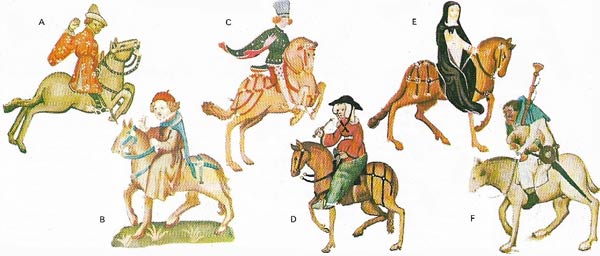
Figure 2. Chaucer's pilgrims were depicted on the Ellesmere manuscript, an author active illuminated text of c. 1400–1410, which may have been written for Chaucer's son Thomas (c. 1367–1434). Shown here are (A) the merchant "with a forked beard, in motelee". As a customs officer, Chaucer was familiar with such great international merchants, the Nun's Priest (B) is not described in the Prologue, but the tale of the Chantecleer reveals a distinctly witty cleric, even if riding a "jade", a horse "both foul and lene". The Wife of Bath (D) is one of Chaucer's most vivid portraits; a middle-aged Venus with a huge amorous appetite who had had five husbands, she was outrageously dressed. The brawny miller (F) was, like most of his type, enterprising and thrusting, benefiting from his lord's monopoly of milling; and the squire (C) was an apprentice in the arts of war and love. Chaucer himself had been a squire in the household of Lionel Duke of Clarence. The Prioress (E), "ful simple and coy" was an exquisitely ironic sketch of an over-refined lady.
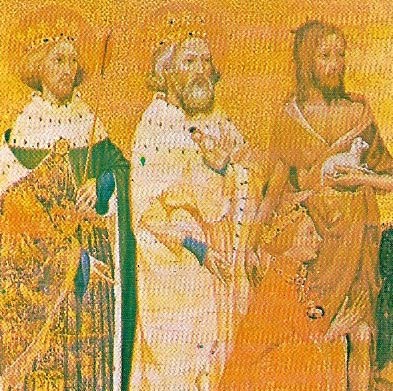
Figure 3. The portrait of Richard II on Wilton Diptych, probably painted for the king himself c. 1395, is by far the best portrait of a medieval English king, and exemplifies the finest achievements of the court culture of his reign. On the back of the diptych the king's emblem – the white hart – is depicted with refinement, probably by John Siferwas, and on the front Richard is seen being ushered into heaven by his patrons Edward the Confessor and Edmund the Martyr. Its painter is unknown.
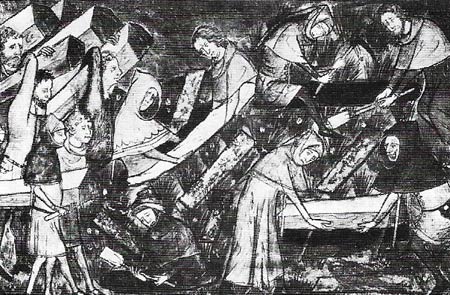
Figure 4. The Black Death (1348–1350) killed probably a third of the population and recurred throughout the next 50 years. The shortage of labor thus created led the peasants to more demands for higher wages.
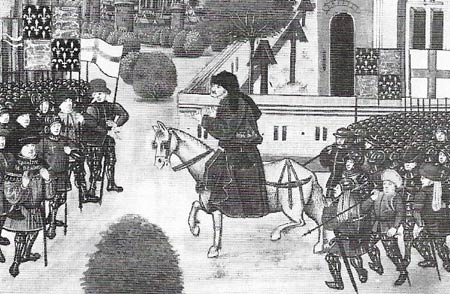
Figure 5. John Ball (d. 1381) was an ex-priest who has been imprisoned for heresy in 1360. He voiced the most radical ideas of the rebels, demanding an end to ancient distinctions between Lord and serf.
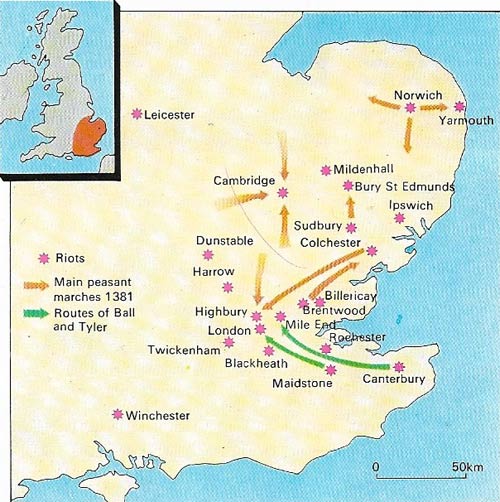
Figure 6. The Peasant's Revolt occurred mainly in the southeast; the rebels in Essex were in touch with those in Kent, from which the main march on London began, and townsmen were involved as much as countrymen. St Albans, Bury St Edmunds and towns in Norfolk all suffered violent movements: a Norfolk man even proclaimed himself king. Isolated incidents occurred as far away as York and Bridgewater, Somerset. In general, risings took place in the prosperous areas where legal restraints such as villeinage no longer had any economic function and merely restricted the virtually independent farmer from pursuing his own fortunes. In addition the London mob was a particularly volatile element in English society, as it would be for many centuries.
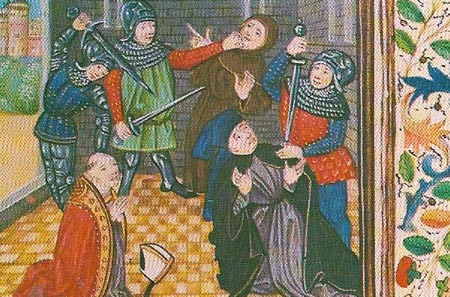
Figure 7. The rebels burned the Savoy Palace of John of Gaunt, and the house of the Chancellor, Sudbury. After the king spoke to the rebels at Mile End, they entered the Tower unopposed and executed Sudbury.
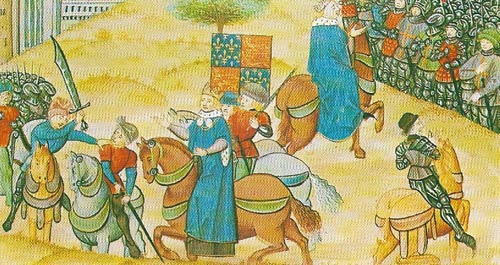
Figure 8. Wat Tyler was killed by the Mayor of London two days after the rebels entered the city. His death ended such unity of purpose as they had possessed. He was described as "endowed with much sense".
Thanks to the poet Geoffrey Chaucer (c. 1345–1400) (Key) the late fourteenth century is more vivid than any other period of medieval English history. In his Canterbury Tales (c. 1385–1400), he describes the pilgrimage, which was a social event that united all classes, and through his immortal sketches of the various pilgrims and the tales they tell along the way he unfolds an ironical, dispassionate but profoundly sympathetic vision of English society (Figure 2).
 |
| Geoffrey Chaucer regularly read his poems to his audience on the royal court. Troilus and Criseyde, which he is reading here, is a fine example of his narrative style, its plot being based on a story by the Italian poet Giovanni Boccaccio (1313–1375). Such borrowing from a foreign culture was typical of the international atmosphere of the court; Chaucer May have met Boccaccio on a diplomatic visit to Italy in the 1370s. The theme of the poem is the traditional one of courtly love, treated with a new attention to personality and emotion. The seduction of high-born ladies was a favorite pastime of Chaucer's audience, and Edward III set an example with his mistress Alice Perrers. |
Chaucer's checkered career
Chaucer himself, with his many-sided experience of life, was perhaps uniquely placed to interpret his age. The son of a London vintner, he learnt the world of the court through his service with Lionel, Duke of Clarence (1338–1368), and later with John of Gaunt, Duke of Lancaster (1340–1399). He served in the French wars and as a diplomatic agent of Edward III (reigned 1327–1377); he was a Justice of the Peace in Kent, sat in parliament for the shire, and was a controller in the port of London. He was several times both creditor and debtor, suffered robbery from highwaymen and was perhaps guilty of rape. London and the court were his special province, and Chaucer the poet probably had in mind a sophisticated court audience. This did not limit his appeal because he was widely known by all classes in his own lifetime.
The growth of a court culture
The age of Chaucer was distinguished by the emergence under Edward III and Richard II (reigned 1377–1399) (Figure 3) of a "court", in the sense of a luxurious and fashionable cultural center. It was sustained by London's new role as the unchallenged metropolis of England, and imbued with the delicate tastes of the rival "court" in Paris. The transformation of a somewhat provincial aristocracy into worldly, elegant courtiers can be observed in many innovations of Chaucer's lifetime: the luxurious appointments of Edward III's new palaces at Eltham and Sheen; the changing fashions of court ladies; the new, subtle style of cuisine; the taste for witty songs and elegant dances, and for poems and stories of delicate refinement, such as Chaucer's Book of the Duchess (1369), a lament for the Duchess of Lancaster, or with a touch of irony, such as his philosophical tragedy Troilus and Criseyde (c. 1385).
Court culture, however, was not simply exquisite or exclusive. At its heart was the broad experience of the world given to men of all classes by the Hundred Years War. This tough but liberating experience gave the nobility an extrovert interest in the ordinary life and character of the plowman as well as the prince. Chaucer's Canterbury Tales with their rich, earthy realism, or the scenes of London low life by Thomas Hoccleve, were not only for the nobility but also a much wider audience — the now literate middling townsmen and countrymen.
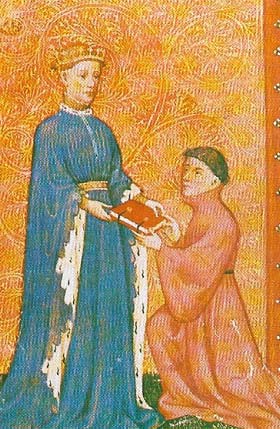 |
| Thomas Hoccleve (c. 1370–c. 1450) is shown presenting his book, Regiment of Princes to the Prince of Wales, who later became Henry V (r. 1413–1422). As in this case, a "patron" was often merely a potential benefactor of the poet who hoped to gain favour by presenting the book. Patronage from a notable member of court was necessary to win a poet recognition, and perhaps a job to enable him to live. Hoccleve was a clerk of the Privy Seal, where his duty was to clothe royal orders and proclamations in elegant prose. His poetry is notable for its realistic and acute observations of life in the London taverns, and centers on his own involvement in that life. |
The Peasants' Revolt
The period of Chaucer's maturity, from the resumption of the war with France in 1369 to the deposition of Richard II in 1399, was the testing-ground of a new popular attention to the activities of government. It was punctuated with eruptions of opposition, sometimes in parliamentary form as in 1376 and 1386, sometimes in a violent defiance of royal authority, as in 1387–1388, when the "Lords Appellant" attacked the court favorites, and as in 1399, when Henry Bolingbroke (1367–1413) overthrew Richard II. Religious controversy, too, was heard at court, stimulated by John Wycliffe (c. 1328–1384) and supported by John of Gaunt and the so-called Lollard knights.
The greatest explosion of all came from the humbler folk of town and country, in the "Peasants' Revolt" of 1381. The name is misleading, for it was really a movement of substantial farmers and tradesmen with a following of farm laborers, infuriated by the constant war-taxation and the arrogance of the officials who collected it.
This followed the social unrest caused by the Black Death (Figure 4) and its consequent recession and upheavals. The Statute of Labourers (1351) tried to restrict the rise in wages that followed the plague. The unrest was ex-pressed by William Langland (c. 1332–1400) in his poem Piers Plowman (c. 1362). Beginning in Essex in June 1381, when one village erupted and killed a tax-collector, the revolt spread as other villages heard of the event (Figure 6). It became a more serious threat when the men of Kent, led by a veteran of the wars, Wat Tyler (died 1381), marched upon London. The 14-year-old Richard II parleyed with them, first at Mile End and then at Smithfield, and promised to grant their demands – an end to serfdom and the dispossession of the nobility and the Church. At Smithfield, however, the Mayor of London, William Walworth, killed Wat Tyler (Figure 8), and Richard, with presence of mind and courage, forthwith persuaded the insurgents to disperse. Reprisals began once the rebels had returned home.
Although the revolt was against a government hated by most people, the excesses of the peasants and their demand for social emancipation alienated the landed classes; Parliament insisted on severe punishment.
Local riots were frequent in subsequent years; the government never again dared to tax the ordinary villager so heavily, and serfdom gradually disappeared in the following generations. In the increasingly complex society of the time, the peasants had shown that they too had interests to protect.
